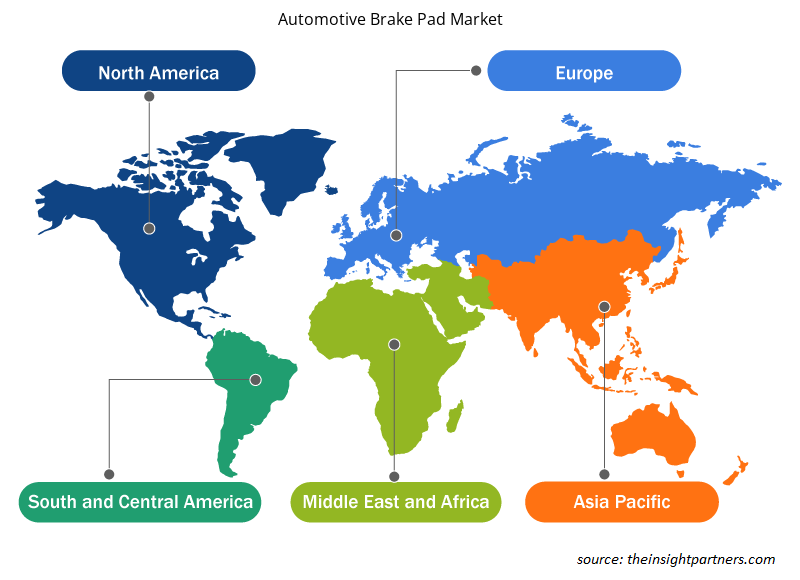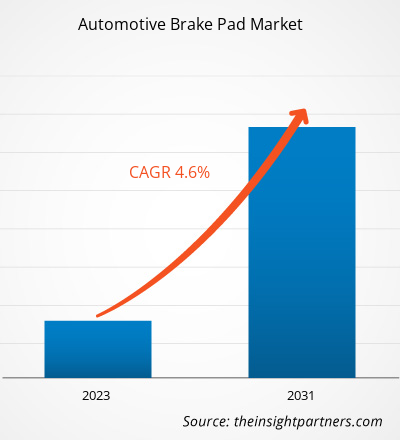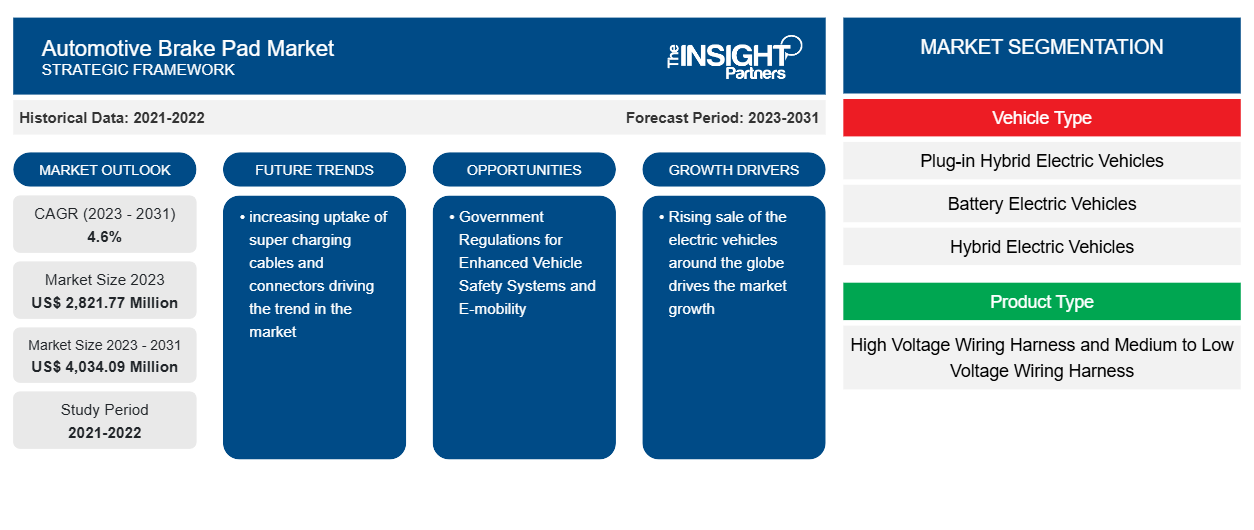Si prevede che la dimensione del mercato delle pastiglie freno per autoveicoli raggiungerà i 4.034,09 milioni di dollari entro il 2031, rispetto ai 2.821,77 milioni di dollari del 2023. Si prevede che il mercato registrerà un CAGR del 4,6% nel periodo 2023-2031. L'aumento delle vendite e della produzione di veicoli commerciali e passeggeri guida la tendenza del mercato.
Analisi del mercato delle pastiglie freno per autoveicoli
Gli sviluppi tecnologici nei booster e nei sistemi elettromeccanici, l'aumento dell'uso di veicoli più performanti e l'aumento della domanda di freni a disco per garantire una maggiore sicurezza stanno guidando la crescita del mercato dei freni a disco per autoveicoli. Tuttavia, gli elevati costi di produzione dei freni a disco potrebbero frenare la crescita del mercato dei freni a disco per autoveicoli. Inoltre, si prevede che il crescente utilizzo di freni a disco ad aria nei veicoli commerciali e la crescente adozione di pastiglie freno in carbonio ceramico creeranno opportunità di mercato per i freni a disco per autoveicoli durante il periodo di previsione.
Panoramica del mercato delle pastiglie freno per autoveicoli
Gli stakeholder chiave nell'ecosistema del mercato globale dei freni a disco per autoveicoli includono fornitori di componenti/hardware, produttori di freni a disco per autoveicoli, enti normativi e di definizione degli standard e degli utenti finali. I fornitori di componenti/hardware forniscono vari componenti/parti/materie prime ai produttori di freni a disco per la produzione del prodotto finale. Pastiglie freno, vite di spurgo, pinze, rotori e hardware.
Il freno a disco è fatto di ghisa, alluminio, acciaio inossidabile e molti altri. Alcuni dei principali attori/produttori del mercato globale dei freni a disco per autoveicoli includono Thermo Fisher Scientific Inc., Brembo SPA, Continental AG, Knorr-Bremse Group e Robert Bosch GmbH tra molti altri. Le pastiglie dei freni sono utilizzate principalmente nelle autovetture, tuttavia, grazie alle loro prestazioni stabili in termini di resistenza alla frenata e velocità più elevate, si stanno diffondendo nel segmento dei veicoli commerciali. Nei veicoli commerciali, i freni a tamburo vengono sostituiti con freni a disco in quanto forniscono una qualità superiore e una durata di servizio più lunga. Anche aziende come Akebono offrono freni a disco.
Personalizza questo report in base alle tue esigenze
Riceverai la personalizzazione gratuita di qualsiasi report, comprese parti di questo report, o analisi a livello nazionale, pacchetto dati Excel, oltre a usufruire di grandi offerte e sconti per start-up e università
-
Scopri le principali tendenze di mercato in questo rapporto.Questo campione GRATUITO includerà analisi di dati che spaziano dalle tendenze di mercato alle stime e alle previsioni.
Driver e opportunità del mercato delle pastiglie freno per autoveicoli
L'aumento del numero di incidenti stradali in tutto il mondo con l'aumento della congestione del traffico guida la crescita del mercato
ci sono diversi altri stakeholder periferici coinvolti nel mercato che svolgono un ruolo cruciale nel consentire la crescita e i progressi tecnologici correlati ai freni a disco per autoveicoli. Il crescente numero di incidenti stradali dovuti ai veicoli sta creando la necessità di normative sulla sicurezza che stanno incoraggiando la necessità di regole per i sistemi frenanti e la sicurezza stradale. Secondo l'Organizzazione Mondiale della Sanità, circa 1,19 milioni di persone muoiono ogni anno. I principali utenti finali del mercato delle pastiglie dei freni per autoveicoli includono autovetture e veicoli commerciali. Inoltre, i crescenti problemi di congestione del traffico nelle aree urbane in tutto il mondo stanno guidando la domanda di prodotti per pastiglie dei freni per autoveicoli durante il periodo di previsione.
Aumento delle vendite di veicoli elettrici per creare ampie opportunità di crescita del mercato
I veicoli elettrici utilizzano pastiglie freno per soddisfare i requisiti di frenata nei veicoli. Le pastiglie freno aiutano a evitare incidenti. Con la crescita crescente del settore dei veicoli elettrici (EV), l'adozione di sistemi frenanti sta crescendo in modo esponenziale. Con l'obiettivo di ridurre l'impatto dannoso delle emissioni sull'ambiente, gli enti governativi che operano a livello globale stanno adottando le misure necessarie per promuovere i veicoli elettrici. Ad esempio, l'Electric Vehicles Initiative è un forum politico multigovernativo che promuove l'introduzione e l'adozione di veicoli elettrici. Con un aumento dell'uso di veicoli elettrici, aumenterà anche la portata dell'uso di sistemi frenanti avanzati. Molte auto elettriche utilizzano sia sistemi frenanti rigenerativi che meccanici insieme. In un sistema frenante per auto elettrica, i sistemi frenanti rigenerativi e meccanici aiutano a risparmiare energia.
Analisi della segmentazione del rapporto di mercato delle pastiglie freno per autoveicoli
I segmenti chiave che hanno contribuito alla derivazione dell'analisi del mercato delle pastiglie dei freni per autoveicoli sono il tipo di materiale, il tipo di veicolo e l'area geografica.
- In base al tipo di materiale, il mercato è suddiviso in pastiglie freno metalliche, pastiglie freno semimetalliche, pastiglie freno in ceramica, pastiglie freno in amianto e pastiglie freno organiche senza amianto. Tra queste, le pastiglie freno metalliche hanno la quota maggiore nel 2023, questo è dovuto all'aumento della domanda nelle autovetture in tutto il mondo.
- A seconda del tipo di veicolo, il mercato è diviso in veicoli commerciali e autovetture. Tra questi, il segmento delle autovetture ha una quota maggiore nel 2023, a causa della quota delle autovetture in tutto il mondo. Secondo l'Organizzazione internazionale dei costruttori di veicoli a motore, le vendite di autovetture a livello globale hanno raggiunto 65,2 milioni di unità nel 2023, in aumento rispetto ai 58,6 milioni di unità in tutto il mondo.
Analisi della quota di mercato delle pastiglie freno per autoveicoli per area geografica
L'ambito geografico del rapporto sul mercato delle pastiglie dei freni per autoveicoli è suddiviso principalmente in cinque regioni: Nord America, Asia Pacifico, Europa, Medio Oriente e Africa, Sud e Centro America.
L'APAC è considerata la regione economica in più rapida crescita, con Cina e India come prima e terza economia in più rapida crescita al mondo. Il Giappone è il paese tecnologicamente più avanzato della regione, offrendo un'opportunità per lo sviluppo del mercato degli pneumatici per autoveicoli. Le economie emergenti del Sud-est asiatico come Vietnam, Malesia e Indonesia stanno sperimentando una crescita nelle vendite di autovetture, quindi si prevede che la domanda di pastiglie freno per autoveicoli aumenterà.
Il Nord America sta crescendo a un ritmo rapido grazie all'aumento delle vendite di automobili negli Stati Uniti e in Canada. Il North American Free Trade Agreement (NAFTA) è un accordo firmato tra Stati Uniti, Canada e Messico. Ciò ha ridotto la maggior parte delle barriere tariffarie e non tariffarie al libero scambio e agli investimenti tra i tre paesi. Ciò ha ulteriormente contribuito ad aumentare il livello di commercio e investimenti nei paesi nordamericani. Inoltre, il Messico sta emergendo come una potenza per la produzione automobilistica NAFTA, fornendo parti per un valore di oltre 4,3 miliardi di $ e veicoli finiti per un valore di 2,6 miliardi di $ ogni mese agli Stati Uniti negli ultimi anni.
Approfondimenti regionali sul mercato delle pastiglie freno per autoveicoli
Le tendenze regionali e i fattori che influenzano il mercato delle pastiglie freno per autoveicoli durante il periodo di previsione sono stati ampiamente spiegati dagli analisti di Insight Partners. Questa sezione discute anche i segmenti e la geografia del mercato delle pastiglie freno per autoveicoli in Nord America, Europa, Asia Pacifico, Medio Oriente e Africa e Sud e Centro America.

- Ottieni i dati specifici regionali per il mercato delle pastiglie freno per autoveicoli
Ambito del rapporto sul mercato delle pastiglie dei freni per autoveicoli
| Attributo del report | Dettagli |
|---|---|
| Dimensioni del mercato nel 2023 | 2.821,77 milioni di dollari USA |
| Dimensioni del mercato entro il 2031 | 4.034,09 milioni di dollari USA |
| CAGR globale (2023-2031) | 4,6% |
| Dati storici | 2021-2022 |
| Periodo di previsione | 2023-2031 |
| Segmenti coperti |
Per tipo di veicolo
|
| Regioni e Paesi coperti |
America del Nord
|
| Leader di mercato e profili aziendali chiave |
|
Densità degli attori del mercato: comprendere il suo impatto sulle dinamiche aziendali
Il mercato delle pastiglie freno per autoveicoli sta crescendo rapidamente, spinto dalla crescente domanda degli utenti finali dovuta a fattori quali l'evoluzione delle preferenze dei consumatori, i progressi tecnologici e una maggiore consapevolezza dei vantaggi del prodotto. Con l'aumento della domanda, le aziende stanno ampliando le loro offerte, innovando per soddisfare le esigenze dei consumatori e capitalizzando sulle tendenze emergenti, il che alimenta ulteriormente la crescita del mercato.
La densità degli operatori di mercato si riferisce alla distribuzione di aziende o società che operano in un particolare mercato o settore. Indica quanti concorrenti (operatori di mercato) sono presenti in un dato spazio di mercato in relazione alle sue dimensioni o al valore di mercato totale.
Le principali aziende che operano nel mercato delle pastiglie freno per autoveicoli sono:
- Coroplast Fritz Müller Gmbh & Co. Kg
- Azienda
- Società elettrica Furukawa Ltd.
- Azienda
- Nexans Autoelectric GmbH
- Azienda elettronica Sinbon.
Disclaimer : le aziende elencate sopra non sono classificate secondo un ordine particolare.

- Ottieni una panoramica dei principali attori del mercato delle pastiglie freno per autoveicoli
Notizie e sviluppi recenti sul mercato delle pastiglie freno per autoveicoli
Il mercato delle pastiglie freno per autoveicoli viene valutato raccogliendo dati qualitativi e quantitativi dopo la ricerca primaria e secondaria, che include importanti pubblicazioni aziendali, dati di associazioni e database. Di seguito sono elencati alcuni degli sviluppi nel mercato delle pastiglie freno per autoveicoli:
- Delphi annuncia il lancio della sua nuova gamma di pastiglie freno BEV dedicate alle esigenze specifiche delle applicazioni BEV. Sulla base di confronti dettagliati, questa gamma è tra le più complete al mondo oggi e copre i modelli più popolari nell'aftermarket indipendente. I veicoli includono Nissan Leaf e Tesla Model S/Model 3, oltre ai modelli più recenti come BMW i4/iX, Mercedes EQC/EQEE/QS e Porsche Taycan/Cross Turismo. Con l'introduzione di 52 numeri di parte che coprono 2,7 milioni di veicoli in funzione in Europa, Delphi offre un'importante opportunità di servizio per le officine. (Fonte: sito Web aziendale, febbraio 2024)
- Allied Nippon ha lanciato EV+, una gamma di pastiglie freno completamente nuova e completa per veicoli elettrici. (Fonte: comunicato stampa, giugno 2023)
Copertura e risultati del rapporto sul mercato delle pastiglie freno per autoveicoli
Il rapporto "Dimensioni e previsioni del mercato delle pastiglie freno per autoveicoli (2021-2031)" fornisce un'analisi dettagliata del mercato che copre le seguenti aree:
- Dimensioni e previsioni del mercato delle pastiglie dei freni per autoveicoli a livello globale, regionale e nazionale per tutti i principali segmenti di mercato coperti dall'ambito
- Tendenze del mercato delle pastiglie dei freni per autoveicoli e dinamiche di mercato come conducenti, sistemi di ritenuta e opportunità chiave
- Analisi PEST e SWOT dettagliate
- Analisi del mercato delle pastiglie dei freni per autoveicoli che copre le principali tendenze del mercato, il quadro globale e regionale, i principali attori, le normative e i recenti sviluppi del mercato
- Analisi del panorama industriale e della concorrenza che copre la concentrazione del mercato, l'analisi della mappa di calore, i principali attori e gli sviluppi recenti per il mercato delle pastiglie dei freni per autoveicoli
- Profili aziendali dettagliati
- Analisi storica (2 anni), anno base, previsione (7 anni) con CAGR
- Analisi PEST e SWOT
- Valore/volume delle dimensioni del mercato - Globale, Regionale, Nazionale
- Industria e panorama competitivo
- Set di dati Excel
Report recenti
Testimonianze
Motivo dell'acquisto
- Processo decisionale informato
- Comprensione delle dinamiche di mercato
- Analisi competitiva
- Analisi dei clienti
- Previsioni di mercato
- Mitigazione del rischio
- Pianificazione strategica
- Giustificazione degli investimenti
- Identificazione dei mercati emergenti
- Miglioramento delle strategie di marketing
- Aumento dell'efficienza operativa
- Allineamento alle tendenze normative























 Ottieni un campione gratuito per - Mercato delle pastiglie dei freni per autoveicoli
Ottieni un campione gratuito per - Mercato delle pastiglie dei freni per autoveicoli